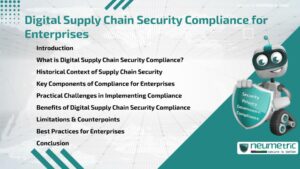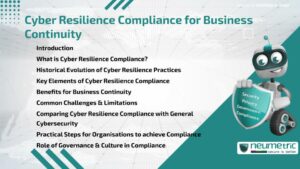Table of Contents
ToggleIntroduction
Cyber resilience compliance is the alignment of an organisation’s security & recovery strategies with regulatory & Industry Standards to ensure Business Continuity. Unlike traditional Cybersecurity, which focuses only on preventing attacks, cyber resilience compliance addresses prevention, response & recovery. This ensures that organisations can withstand disruptions while meeting compliance obligations. For enterprises, this approach reduces downtime, safeguards critical data & reassures Stakeholders that operations remain resilient against growing Threats.
What is Cyber Resilience Compliance?
Cyber resilience compliance refers to meeting defined standards & regulations that demand organisations not only protect their systems but also recover quickly after incidents. It involves integrating Cybersecurity controls, Disaster Recovery plans & Business Continuity measures into one Framework.
For example, a company hit by ransomware must not only defend against the attack but also show regulators it has measures to continue essential services while restoring systems securely. This blend of protection & accountability makes compliance a cornerstone of modern resilience.
Historical Evolution of Cyber Resilience Practices
Initially, organisations relied heavily on perimeter security such as firewalls & antivirus tools. However, as attacks grew more sophisticated, it became clear that no defense could guarantee total protection. Events such as large-scale data breaches & nation-state cyberattacks highlighted the need for broader strategies.
Regulatory frameworks soon followed, requiring not only preventive measures but also recovery & continuity planning. Standards such as ISO/IEC 22301 for Business Continuity & NIST’s Cybersecurity Framework formalised cyber resilience compliance. Today, industries such as Finance, Healthcare & energy treat it as a regulatory requirement rather than a best practice.
Key Elements of Cyber Resilience Compliance
A strong cyber resilience compliance program includes several elements:
- Risk Assessment: Identifying Threats & Vulnerabilities to critical operations.
- Preventive Security Controls: Firewalls, encryption & identity management.
- Incident Response Planning: Clear steps for detecting & containing cyber incidents.
- Business Continuity & Recovery: Ensuring operations can continue despite disruptions.
- Testing & Auditing: Regular exercises to verify preparedness & compliance.
- Governance Integration: Embedding resilience into Policies & oversight.
Together, these elements ensure both regulatory alignment & practical resilience.
Benefits for Business Continuity
Adopting cyber resilience compliance offers significant benefits:
- Minimises downtime during cyber incidents
- Protects Sensitive Data & reputation
- Reduces regulatory penalties for non-compliance
- Builds Customer & Stakeholder trust
- Ensures long-term Business Continuity in complex Threat environments
Organisations that adopt this approach transform compliance from a checkbox activity into a driver of resilience.
Common Challenges & Limitations
Despite its advantages, cyber resilience compliance presents challenges:
- Resource Limitations: Smaller organisations may lack funds for advanced tools.
- Complex Regulatory Landscape: Different regions impose varying requirements.
- Cultural Resistance: Staff may see compliance as an extra burden rather than essential.
- Evolving Threats: Cybercriminal tactics change faster than compliance frameworks.
- Testing Fatigue: Frequent drills may disrupt normal operations.
Addressing these issues requires balancing compliance with practical realities.
Comparing Cyber Resilience Compliance with General Cybersecurity
General Cybersecurity focuses primarily on protection — firewalls, antivirus & patching. Cyber resilience compliance, however, expands this scope to include response & recovery.
This can be compared to building safety: installing fire alarms is Cybersecurity, while having evacuation drills, fire-resistant structures & recovery plans is cyber resilience compliance. Both are needed, but resilience ensures survival when prevention fails.
Practical Steps for Organisations to achieve Compliance
To achieve cyber resilience compliance, organisations should:
- Map Critical Assets & processes requiring continuity.
- Align Policies with recognised standards like NIST or ISO/IEC 22301.
- Develop & document Incident Response & recovery plans.
- Train staff on resilience responsibilities & awareness.
- Use technology to monitor Threats & automate responses.
- Conduct regular Audits & update compliance frameworks.
These steps provide a roadmap for sustainable resilience.
Role of Governance & Culture in Compliance
Governance & organisational culture are central to cyber resilience compliance. Boards & leadership must oversee compliance as part of corporate strategy, not just IT operations. At the same time, Employees must embrace a culture of resilience, treating compliance as shared responsibility.
When Governance & culture align, compliance becomes proactive, strengthening both security & continuity.
Takeaways
- Aligns resilience with regulatory & Industry Standards
- Ensures operations continue during disruptions
- Strengthens trust with Stakeholders & regulators
- Reduces penalties & reputational harm
- Requires Governance & cultural integration
FAQ
What is cyber resilience compliance?
It is the process of aligning security, recovery & continuity strategies with Regulatory Standards to ensure resilience during cyber incidents.
Why is cyber resilience compliance important?
It ensures Business Continuity, reduces downtime & builds trust with Customers & regulators.
How is cyber resilience compliance different from Cybersecurity?
Cybersecurity focuses on protection, while cyber resilience compliance includes prevention, response & recovery to maintain continuity.
Which industries require cyber resilience compliance most?
Sectors like Finance, Healthcare, energy & Government prioritise compliance due to critical operations & strict regulations.
What challenges exist in achieving compliance?
Challenges include resource constraints, regulatory complexity, evolving Threats & resistance to cultural change.
What standards guide cyber resilience compliance?
Frameworks like NIST Cybersecurity Framework & ISO/IEC 22301 provide guidance for aligning security & continuity.
How can organisations start building compliance?
They can begin with Risk Assessments, Incident Response plans, staff training & aligning with Global Standards.
Need help for Security, Privacy, Governance & VAPT?
Neumetric provides organisations the necessary help to achieve their Cybersecurity, Compliance, Governance, Privacy, Certifications & Pentesting needs.
Organisations & Businesses, specifically those which provide SaaS & AI Solutions in the Fintech, BFSI & other regulated sectors, usually need a Cybersecurity Partner for meeting & maintaining the ongoing Security & Privacy needs & requirements of their Enterprise Clients & Privacy conscious Customers.
SOC 2, ISO 27001, ISO 42001, NIST, HIPAA, HECVAT, EU GDPR are some of the Frameworks that are served by Fusion – a SaaS, multimodular, multitenant, centralised, automated, Cybersecurity & Compliance Management system.
Neumetric also provides Expert Services for technical security which covers VAPT for Web Applications, APIs, iOS & Android Mobile Apps, Security Testing for AWS & other Cloud Environments & Cloud Infrastructure & other similar scopes.
Reach out to us by Email or filling out the Contact Form…





